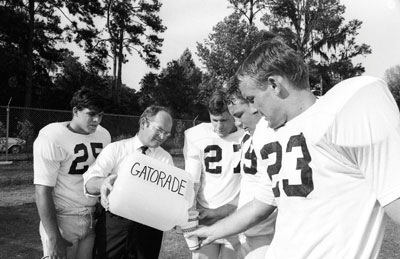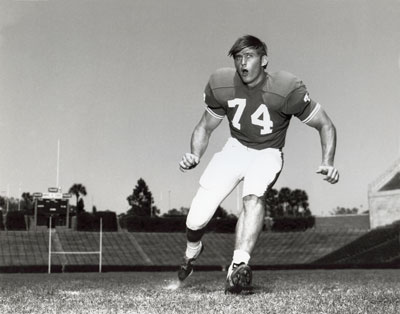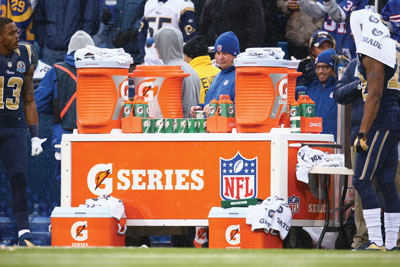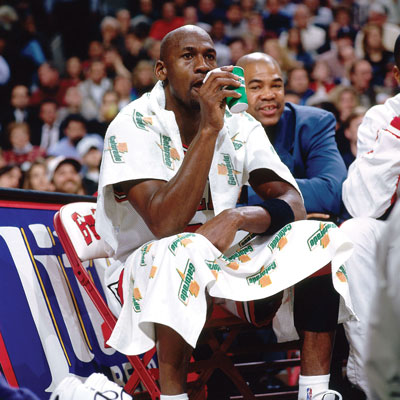Hall of famer Jack Youngblood vividly recalls his first swig of Gatorade on a scorching Florida football field — and it isn’t a fond memory.
“The stuff we drank at first was just nasty,” said Youngblood, who played defensive end at the University of Florida from 1967-70.
An unnamed formulation of Gatorade was first tested on Florida football players in 1965 — three years before it was sold to consumers. Two years later, initial versions were still being tested on the Gator football team that gave the sports drink its name.
“Sometimes, it was thick and salty, sometimes it was thin and sweet, and sometimes it changed color,” Youngblood
 |
Gatorade inventor Dr. Robert Cade tested early blends of the sports drink on University of Florida football players.
Photo by: Gatorade |
recalled, “but most times, it was just nasty. More than once we accused Dr. [Gatorade inventor Robert] Cade and our trainer, Brady Greathouse, of trying to kill us.”
Some 50 years later, Gatorade has grown into a $4 billion global brand and Youngblood’s opinion of the beverage has changed.
“About a year later, they got the witch’s brew right and we could see it was working for us,” said Youngblood, who still drinks Gatorade and now runs a family farming business. “Four billion? Now if they could have just given every Gator player just one share …”
In fact, Greathouse did receive a few original shares, the beginning of a symbiotic relationship between the brand that pioneered sports drinks and the men who control locker rooms and to some extent what goes into the bodies of the athletes within them.
Ask any Gatorade marketer, old or new, why the brand has endured for 50 years and he or she inevitably harks back to Cade and the lab at Florida where he and fellow scientists first took on the battle against dehydration.
 |
Jack Youngblood says that during his Florida playing days, he was glad when "they got the witch's brew right."
Photo by: Getty Images |
“We sell a lot more flavors [around 40] than when I started,” said team sports manager Skeeter Schuessler, with Gatorade since 1988, “but the main thing that sets us apart is still the science behind the product.”
Like Nike, Gatorade’s growth has been tied to athlete performance. Gatorade also has managed to stay relevant to its consumers over 50 years, also an integral part to Nike’s enduring success. That’s not easy with a young, skeptical and flighty group of teen consumers.
“The best brands figure out how to move effortlessly from generation to generation, and Gatorade is no different,” said Jeff Urban, who worked at Gatorade from 1999-2009, last serving as senior vice president of sports marketing. “It was founded with a singular purpose that hasn’t changed.”
In his office high above Chicago’s streets, Brett O’Brien, Gatorade general manager and senior vice president, echoed that sentiment.
“Gatorade wasn’t built as a mass-market consumer brand, it was built for the field of play,” O’Brien said, uttering words not spoken in reference to many PepsiCo brands.
Or as Gatorade Chief Marketing Officer Morgan Flatley put it succinctly, “We’re not trying to create a story, we have one. Our job is simply to ground the next generation of consumers in that authentic heritage.”
Regimen of trainers
If there’s a claimed hero in the story of Gatorade’s marketing saga, it’s the early decision to align the brand with athletic trainers. Gatorade helped found and fund many of the early professional trainer organizations.
“The one thing that never gets enough credit was what we called professional marketing,” said former 15-year Gatorade sports marketing chief Bill Schmidt, the last American to win an Olympic medal in the javelin (1972). “As an athlete, I knew how powerful they were.”
The “born in a lab and proved on athletic fields” story was even more powerful when it was told by the men who controlled the locker rooms and sidelines.
“We viewed the trainers and exercise physiologists as the No. 1 customers for Gatorade and they were the keys to
 |
Getting trainers on board paved the way to getting Gatorade on the sidelines.
Photo by: Getty Images |
us getting the sidelines,” said former Quaker Oats President Phil Marineau, who helped grow Gatorade from $70 million in annual sales to a billion-dollar brand during his 23 years at the food and beverage company. “Some NFL owners had their own [sports] drinks and their trainers told them, ‘I am not giving that to my athletes.’”
Given its heritage, Gatorade was always marketed as essential sports equipment, more like a tackling dummy than an elixir that would imbue users with superhuman powers. That fit perfectly with the sideline strategy and allowed Gatorade to push into the beverage category at sports venues. It was a time when TV sports were exploding, so exposure grew geometrically.
Coke and Pepsi had been buying scoreboards at sports venues for the prior five decades. Gatorade’s inroads with the trainers helped it get cups and coolers on pro sidelines, without which there would have never been a “Gatorade dunk” of the winning coach.
So embedded were Gatorade marketers within the sports community that Pepsi employees had problems dealing with it after Pepsi acquired Gatorade parent Quaker Oats for $13.4 billion in 2001.
“Pepsi didn’t know what to do with it at first, because sales were so hand-to-hand,” O’Brien said. “It was about knowing the athletic director well enough that you sold to him directly.”
Again, things haven’t changed much when it comes to the gatekeepers for pro and college locker rooms. “We can still stand in front of a room filled with trainers and say, ‘If you think there’s something better, prove it,’” said 10-year Gatorade veteran Jeff Kearney, who heads U.S. sports marketing. “Protecting that integrity has helped us endure.”
Serious science
Professional endurance athlete Chris Legh insists he’s out of shape, but his effortless strides atop a treadmill on which the speed and incline increase precipitously over 25 minutes belie his assertion.
We’re at the Gatorade Sports Science Institute in Barrington, Ill., where a team of around 20 scientists try to ensure that Gatorade’s 50-year-old claims of efficacy live on.
Legh, who suffered an agonizing, near-death collapse from dehydration some 165 feet before the end of the 1997 Ironman Triathlon in Kona, Hawaii, sought help at GSSI. The result: a new hydration strategy, a victory in a 2004 Ironman event and another memorable Gatorade ad.
 |
Signing Michael Jordan as an endorser in 1991 brought the "Be Like Mike" ad campaign.
Photo by: NBAE / Getty Images |
“Working with the people here gave me some real baselines to work from,” Legh said just after completing a treadmill test designed to gauge an athlete’s “fuel profile,” or whether their bodies burn more fat or carbohydrates during exercise. “I went from a guessing game on hydration to having real data and a program and that just gave confidence.”
Institute head James Carter said GSSI has tested around 2,000 athletes in its 27 years, including, more recently, Bryce Harper, Abby Wambach, Serena Williams and Cam Newton.
“Legh is a well-documented case, but we have changed the habits of most of the athletes that have come in here, at least in a small way,” said Carter, a marathoner whose doctoral research focused on endurance athletes’ carbohydrate intake. “As a scientist, I’m biased, but for me [Gatorade’s] lasted 50 years because it was led by science, then product followed. The day it stops being science-led is the day that we’ll part company.”
Marineau said that when Quaker Oats acquired Gatorade in 1983, the first order was replicating research all the way back to the Florida football fields and Cade’s nearby lab. It was all substantiated. Finding an effective way to communicate those benefits and be heard through a cacophony of beverage marketing was the next priority.
“The notion of Gatorade being the ultimate thirst-quencher, because it quickly replaces lost fluids and minerals, resonated with consumers right away,” Marineau said, “but the notion that you would drink the stuff and be at full-strength again was something people found preposterous in 1984. So that ‘recharge’ was never our claim. People discovered on their own.”
Sounds a lot like what Shawna Ryan, Gatorade’s current director of youth activation, is trying to achieve.
“We know [youth] athletes are sort of half-listening to their coaches and trainers talk about Gatorade,” Ryan said. “The ‘aha’ moment is when they feel it working on the field. That’s what we are striving for from a grassroots perspective, because that’s when they decide ‘This brand is for me.’”
Gatorade’s advertising triumphs mirror to some degree its success in creating a consumer product, certainly not the original intent of Cade and the other scientists who founded the Gatorade Trust. The beverage was not on retail shelves until 1968. Early versions of Gatorade were so salty that they ate through the cans in which they were packaged.
A similar exercise in self-destruction surrounded the Gatorade jingle heard from 1984 to 1990: “Gatorade is thirst-aid, for that deep-down body thirst.” The campaign worked as sales grew from around $170 million to almost $900 million. However, Sands, Taylor & Wood held the “Thirst-Aid” trademark for beverages (including a discontinued sports drink) and other food products. The company eventually was awarded more than $16 million for trademark infringement.
Gatorade followed with “Life is a sport, drink it up,” a rare suggestion of off-field use that was as forgettable as whatever Michael Jordan did for Coke as a pitchman before he became the first Gatorade endorser in 1991.
Then it followed in 1999 with “Is it in you?” “That was magic,” said Greg Via, Gatorade’s director of worldwide sports marketing from 1986-99. “It was just a great message of efficacy and, of course, it made you want to drink some.”
The 1991 “Be Like Mike” TV ad (reprised for a 50th anniversary encore, along with some new adaptations) heralded an era of award-winning creative work. There was soccer great Mia Hamm battling Jordan in a variety of sports challenges, including soccer and basketball. It presaged a later ad in which a younger Jordan (No. 23) took on a more seasoned MJ (No. 39) in a one-on-one basketball game.
Mark Thomashow, the senior global director of business affairs and brand communications for Nike, phoned Gatorade Sports Marketing Chief Tom Fox to relay the ultimate compliment from Nike’s founder.
“Phil Knight thought it was an ad Nike should have done,” said Fox, now chief executive at Premier League team Aston Villa. “We did ads 25 years ago people remember and the beauty was that it was always about the athlete and the trainers. In telling their stories we could build significant brand, but the marketing was never the star. The brand had all the ego we needed.”
Post Pepsi
While Quaker Oats garnered significant distribution for Gatorade, particularly within convenience stores, Pepsi’s acquisition in 2001 helped move it from the juice aisle to the soft drink aisle and within bodegas and smaller markets, the “up and down the street trade.”
While the brand expanded to its current $4 billion in sales under Pepsi, more than one former Gatorade marketer accused the soft drink and beverage giant of “treating the brand like a cola.”
“Pepsi did what we tried not to,” Marineau said. “Stack it high and sell it cheap.”
Through the last few years of the 2000s, Gatorade yielded share to competitors as product focus slipped and advertising stopped stressing benefits. Gatorade also shifted its marketing to a campaign and logo focused on the letter “G,” which some found confusing.
Share loss appears to have stabilized with Gatorade more recently steady at around 75 percent of the U.S. sports drink market.
Most of the old-timers see a 2008 Super Bowl ad, which showed only a dog drinking from his bowl, as the brand’s marketing nadir.
“If you can’t kill it with that,” said one former Gatorade marketer, “then yes, this is a brand that can’t be killed.”
More recently, Gatorade’s social media command center has won praise from the multitude of marketers still attempting to figure out the medium. An example from the NBA in 2014 was a quick response tweet after Gatorade was being held responsible on social media for LeBron James cramping up. “Wasn’t our client. Our athletes can take the heat,” read the tweet.
The story of Gatorade pioneering a category and its endurance over 50 years is 33 percent efficacy, 33 percent the marvelous tales no marketer could manufacture and 33 percent creative, original and impactful marketing: everything from targeting trainers, to ownership of the sidelines and unforgettable advertising with Jordan, who had a similar growth effect on Nike.
“The fact that the brand endures starts from the fact that it works,” O’Brien said. “We support that with the appropriate marketing and we monitor brands like Under Armour and Nike to see how they reinvent themselves, how they combine the science of apparel and footwear with what’s happening in entertainment and youth culture.
“Generally, doing things with a big bang is not us and the key here is staying true to who we are.”
Echoed Schmidt: “Gatorade’s roots are real and authentic. Because of that, our notion from the beginning was putting it at the point of sweat from kids to colleges to pros, and on every sideline, if we could. That combination has sustained the brand more than anything else.”







